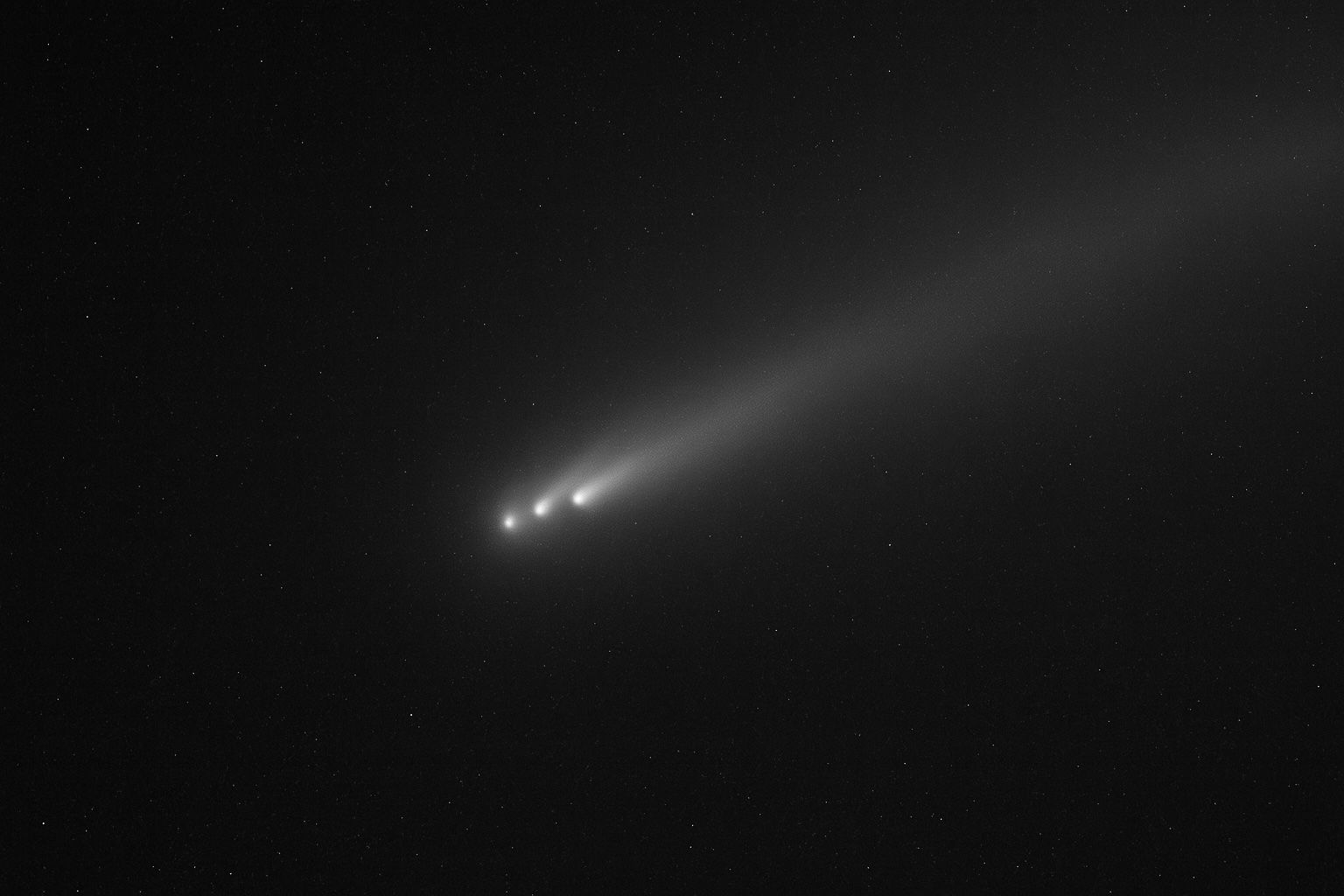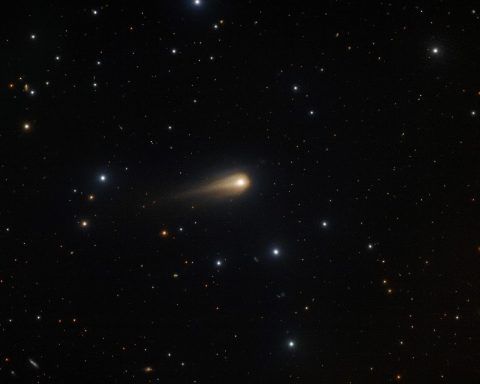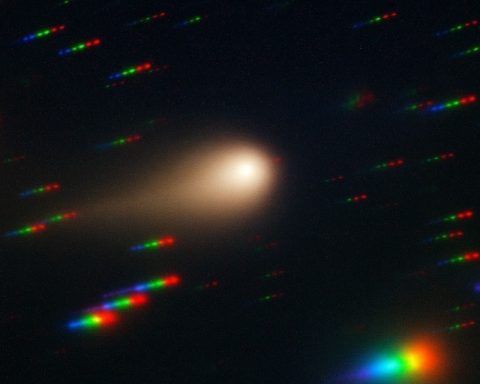On Wednesday, November 19, 2025, the interstellar comet 3I/ATLAS is center stage: NASA is set to unveil its sharpest images yet of this rare object, while ISRO scientists in India share fresh observations from their Mount Abu telescope. Here’s everything you need to know today about what’s happening, why it matters, and how to watch. [1]
Today’s Big 3I/ATLAS Headlines (Nov. 19, 2025)
NASA’s live reveal at 3 p.m. ET
NASA is holding a live media event at 3 p.m. Eastern Time today from Goddard Space Flight Center in Greenbelt, Maryland, to unveil new imagery of 3I/ATLAS collected by multiple space- and ground-based observatories. [2]
Key points:
- Time: 3 p.m. ET (2000 GMT) today, Nov. 19, 2025 [3]
- Where to watch:
- NASA+ streaming service
- NASA app
- NASA’s main website and YouTube channel
- Amazon Prime (via NASA’s channel) [4]
- Who’s speaking: NASA Associate Administrator Amit Kshatriya, heliophysics chief Nicky Fox and other senior scientists will discuss the comet’s latest images and science results. [5]
A NASA Science “3I/ATLAS” hub is also streaming related content and linking to the live event, underscoring how high a priority this interstellar visitor has become. [6]
New ISRO observations from Mount Abu, India
Also today, India’s ISRO–affiliated Physical Research Laboratory (PRL) released new results from its 1.2‑meter telescope at Mount Abu, which tracked 3I/ATLAS between November 12–15 as it moved away from the inner solar system after its closest approach to the Sun. [7]
What ISRO reports:
- Fresh imaging and spectroscopy: The team obtained both images and spectra of the comet.
- A near‑circular coma: False-color images show a rounded, glowing envelope of gas and dust surrounding the nucleus — classic active‑comet behavior powered by solar heating. [8]
- Typical comet chemistry: Spectra reveal familiar molecular emission bands such as CN, C₂ and C₃, which are standard in many solar‑system comets and help constrain the comet’s composition and activity level. [9]
- Contribution to global campaign: PRL notes that these ISRO‑linked observations add to the worldwide effort to characterize 3I/ATLAS’s structure and chemistry as it recedes. [10]
India Today’s science desk describes the Mount Abu results as proof that 3I/ATLAS is once again an accessible telescopic target after emerging from behind the Sun earlier this month. [11]
Reuters: “Oldest thing we’ve seen up close”
A widely shared Reuters story today frames 3I/ATLAS as “probably even older than our solar system”, quoting astrophysicist Chris Lintott, who notes it may be more than 8 billion years old, compared with Earth’s 4.5‑billion‑year neighborhood. [12]
That same report emphasizes that:
- 3I/ATLAS passed about 19 million miles (30 million km) from Mars last month.
- It will get no closer than roughly 170 million miles (275 million km) from Earth and poses no impact risk. [13]
- Despite online speculation, NASA experts stress its behavior is entirely consistent with a natural comet. [14]
What Is Comet 3I/ATLAS?
A rare interstellar visitor
3I/ATLAS is only the third confirmed interstellar object ever spotted passing through our solar system, after 1I/ʻOumuamua (2017) and 2I/Borisov (2019). [15]
- Designation: 3I/ATLAS, also known as C/2025 N1 (ATLAS). [16]
- Discovery: First reported on July 1, 2025 by the ATLAS survey telescope in Río Hurtado, Chile, with pre‑discovery images going back to mid‑June. [17]
- Why “3I”? “I” stands for “interstellar,” and “3” marks it as the third of its kind. “ATLAS” honors the discovery program. [18]
Both NASA and ESA classify it as an interstellar comet because its orbit is clearly hyperbolic: if you trace its path backwards, it does not loop around the Sun but instead comes from deep interstellar space and will never return. [19]
Size, speed and orbit
From combined Hubble, JWST and ground‑based observations, astronomers estimate: [20]
- Nucleus size: Roughly 0.3–5.6 km across (probably under 1 km), though the bright coma makes this tricky to pin down. [21]
- Maximum speed near perihelion: About 68 km/s (≈245,000 km/h), making it one of the fastest “visitors” ever measured in the inner solar system. [22]
- Closest to the Sun: Around October 29–30, 2025, at roughly 1.4 AU (about 203 million km), just inside Mars’ orbit. [23]
- Closest to Earth: Expected around December 19, 2025, at about 1.8 AU / 270 million km, on the far side of the Sun — safely distant. [24]
ESA’s FAQ notes that 3I/ATLAS’s age is likely several billion years, inferred from its extreme speed and interstellar origin; science coverage in outlets like Live Science and Reuters places it around 7–8 billion years old, significantly older than the Sun. [25]
What is it made of?
Spectra from JWST, Hubble, ESA’s observatories and large ground‑based telescopes show that 3I/ATLAS is made of broadly familiar cometary materials, but in intriguing proportions: [26]
- Plentiful carbon dioxide (CO₂) dominating the coma
- Smaller but significant amounts of water ice and vapor, carbon monoxide, and carbonyl sulfide
- Typical cometary gases like cyanide (CN)
- Vaporized nickel at levels similar to some solar‑system comets and 2I/Borisov
A controversial report highlighted a possible plume containing nickel but little or no iron, forming the industrially familiar compound nickel tetracarbonyl, which prompted speculation from Harvard astrophysicist Avi Loeb about a non‑natural origin. [27] Most comet researchers, however, argue that unusual metal chemistry alone isn’t evidence of technology and note that nickel‑rich outgassing has precedents in other comets. [28]
Where Is 3I/ATLAS in the Sky Today?
If you’re hoping to actually spot 3I/ATLAS on November 19, 2025, here’s the status:
- According to live ephemerides from TheSkyLive, 3I/ATLAS is currently in the constellation Virgo, with an observed brightness around magnitude 9.8 today — much brighter than some early predictions. [29]
- Its apparent position today is roughly:
- RA: 12h 39m
- Dec: –3° (approx., J2000 coordinates near 12h 37m, –2° 41′) [30]
- At magnitude ~10, it’s a telescopic object: you’ll need a small to medium amateur telescope under dark skies; it will not be visible to the naked eye. [31]
Sky & Telescope reports that while another comet, C/2025 K1 (ATLAS), is actively breaking apart, interstellar 3I/ATLAS is “delighting” observers with a brighter‑than‑expected coma and tail — so double‑check that any “comet ATLAS” story you see is about the right object. [32]
Recent astrophotography from both professional and amateur observers shows a complex structure:
- Images from astrophotographer Satoru Murata earlier this week reveal multiple jets, an anti‑tail (dust apparently pointing sunward from our viewpoint) and a long, tightly collimated tail stretching away from the Sun. [33]
- Amateur astronomers posting on Reddit describe a faint main tail over a degree long, with a shorter anti‑tail visible in wide‑field images taken on November 17. [34]
All of this adds up to a comet that’s visually dynamic under the eyepiece, even if it’s beyond reach of unaided eyes.
How to Watch NASA’s 3I/ATLAS Reveal Today
If you can’t get to a telescope, today’s NASA event is the next best thing.
When:
- Wednesday, November 19, 2025
- 3:00 p.m. Eastern Time (2000 GMT) [35]
Where to watch live:
- NASA+ (NASA’s streaming platform)
- NASA app (iOS, Android)
- Livestream on NASA.gov and the NASA YouTube channel
- Amazon Prime via NASA’s video channel [36]
Space.com and Live Science are also embedding the stream and running live coverage, while broadcasters such as LiveNOW from FOX and major news portals (including Yahoo) are pointing viewers to the event and answering FAQs like “Is 3I/ATLAS coming to Earth?” (short answer: no). [37]
Expect NASA to showcase:
- Multi‑wavelength images from Hubble, JWST, Mars orbiters, and other missions in its “fleet” of comet watchers [38]
- Animations of the comet’s hyperbolic trajectory through the solar system [39]
- Updates on composition, activity, tail structure and what these reveal about its home star system
What We’ve Learned So Far About 3I/ATLAS
A time capsule older than the Sun
Taken together, NASA, ESA and independent teams portray 3I/ATLAS as a fossil from another star system, likely formed billions of years before our own Sun ignited: [40]
- Its extreme speed and unbound orbit show it’s not gravitationally tied to the Sun. [41]
- Age estimates of 7–8+ billion years suggest it formed in a now‑ancient planetary system and has been drifting through deep space ever since. [42]
- Its rich CO₂ coma and mix of volatiles trace conditions in that long‑gone system’s outer regions, a unique probe of “exo‑Kuiper belts.” [43]
Radio signals — natural, not alien
Last week, astronomers using South Africa’s MeerKAT radio telescope reported the first radio detections from 3I/ATLAS. The signals come from hydroxyl (OH) radicals produced when sunlight breaks apart water molecules expelled by the comet — a textbook cometary process. [44]
Although some social media chatter framed this as “radio from an alien spacecraft,” the observing team and other experts are clear: the emission is entirely consistent with normal comet outgassing, just detected from an interstellar object for the first time. [45]
Alien spacecraft? Scientists say “no”
Harvard’s Avi Loeb has argued in op‑eds and interviews that 3I/ATLAS’s trajectory, unusual metal chemistry and line‑of‑sight coincidence with the famous “Wow! signal” justify at least considering an artificial origin. [46]
Mainstream researchers strongly disagree:
- ESA comet scientist Michael Küppers notes that 3I/ATLAS “looks like a comet and behaves like a comet”, with no need for exotic explanations. [47]
- NASA‑funded ATLAS co‑investigator Larry Denneau points out that its path matches what you’d expect from gravity alone, showing no anomalous accelerations or course changes. [48]
- Chris Lintott bluntly characterizes the alien‑craft idea as “nonsense,” emphasizing that every observation so far fits well within the range of known comet behavior. [49]
In other words: 3I/ATLAS is weird in scientifically exciting ways, not in “secret spaceship” ways.
A Global Fleet Watching 3I/ATLAS
One of the most impressive aspects of this encounter is how many observatories — on and off Earth — are coordinated to watch a single icy rock: [50]
- NASA missions: Hubble, JWST, TESS, Swift, SPHEREx, the Perseverance and Curiosity rovers on Mars, Mars Reconnaissance Orbiter, Parker Solar Probe, PUNCH, Psyche, Lucy, Europa Clipper, plus the ESA/NASA SOHO mission. [51]
- ESA missions: Mars Express and ExoMars Trace Gas Orbiter have already observed the comet near its close pass by Mars (about 29 million km on Oct. 3). Data from these spacecraft sharpened its orbital path by a factor of ten. [52]
- ESA’s Juice mission is attempting additional observations this month from its vantage near the Sun, though the data may not reach Earth until early 2026 because the spacecraft is currently using a slower link. [53]
- Ground‑based telescopes: From Mount Abu in India to professional observatories in Chile and amateur scopes worldwide, the comet is being watched from multiple longitudes and latitudes. [54]
Together, this gives astronomers a multi‑perspective, multi‑wavelength 3D view of an object that formed around another star — a science opportunity we’ve only had twice before in history.
Is Comet 3I/ATLAS Coming Toward Earth?
Short answer: No.
Every major space agency and independent orbit solution agrees that: [55]
- 3I/ATLAS follows a hyperbolic escape trajectory; it’s not bound to the Sun.
- It already passed its closest approach to the Sun at the end of October.
- It will never come closer than roughly 1.8 AU (≈270 million km / 170 million miles) from Earth, and that closest point happens when the comet is behind the Sun relative to us.
So while the comet is a star of today’s news cycle, it is not a star of any credible impact‑hazard scenario. ESA’s Planetary Defence Office tracks it largely as an exercise in interstellar‑object monitoring, not as a threat. [56]
What Happens After Today?
After the excitement of today’s NASA reveal, 3I/ATLAS will quietly continue its one‑time flythrough of our neighborhood:
- Through late November and December it should remain a good telescopic target, though gradually fading as it recedes. [57]
- ESA’s Juice spacecraft will send back its November observations in early 2026, giving scientists a delayed but valuable look from the outer solar system. [58]
- NASA and ESA will keep updating their 3I/ATLAS hubs with refined size estimates, improved composition measurements and trajectory updates as more data are processed. [59]
Eventually, the comet will fade from even the largest telescopes’ view, heading back into the galactic dark — taking its secrets with it, except for what we can capture now.
Fast Facts: Comet 3I/ATLAS at a Glance
- Type: Interstellar comet (3rd known interstellar visitor) [60]
- Discovered: July 1, 2025, by the ATLAS survey in Chile [61]
- Origin: Outside the solar system; on a hyperbolic escape trajectory [62]
- Closest Sun approach: Oct. 29–30, 2025 (~1.4 AU) [63]
- Closest Earth approach: ~Dec. 19, 2025 (~1.8 AU / 270 million km), behind the Sun [64]
- Size: Likely under 1 km across (0.3–5.6 km range) [65]
- Composition: CO₂‑rich comet with water, CO, carbonyl sulfide, CN and nickel vapor [66]
- Current sky position (Nov. 19): In Virgo, around magnitude 9.8, telescopic only [67]
- Risk to Earth: None; minimum distance ≈1.8 AU and receding [68]
If you’re publishing this for Google News or Discover, you can easily add a short “How to watch NASA’s 3I/ATLAS press conference” box or an FAQ sidebar using the headings above. The key for today, November 19, 2025, is simple: all eyes — and telescopes — are on a tiny, ancient comet from another star system, and we’re getting our best look yet.
References
1. www.reuters.com, 2. www.nasa.gov, 3. www.nasa.gov, 4. www.nasa.gov, 5. www.nasa.gov, 6. science.nasa.gov, 7. www.indiatoday.in, 8. www.indiatoday.in, 9. www.indiatoday.in, 10. www.indiatoday.in, 11. www.indiatoday.in, 12. www.reuters.com, 13. www.reuters.com, 14. www.reuters.com, 15. www.esa.int, 16. en.wikipedia.org, 17. science.nasa.gov, 18. www.esa.int, 19. science.nasa.gov, 20. science.nasa.gov, 21. science.nasa.gov, 22. en.wikipedia.org, 23. science.nasa.gov, 24. www.esa.int, 25. www.esa.int, 26. science.nasa.gov, 27. nypost.com, 28. www.theguardian.com, 29. theskylive.com, 30. theskylive.com, 31. en.wikipedia.org, 32. skyandtelescope.org, 33. avi-loeb.medium.com, 34. www.reddit.com, 35. www.nasa.gov, 36. www.nasa.gov, 37. www.space.com, 38. science.nasa.gov, 39. science.nasa.gov, 40. science.nasa.gov, 41. en.wikipedia.org, 42. www.reuters.com, 43. science.nasa.gov, 44. www.livescience.com, 45. www.livescience.com, 46. www.theguardian.com, 47. www.theguardian.com, 48. www.reuters.com, 49. www.reuters.com, 50. science.nasa.gov, 51. science.nasa.gov, 52. www.esa.int, 53. www.esa.int, 54. www.indiatoday.in, 55. science.nasa.gov, 56. www.esa.int, 57. theskylive.com, 58. www.esa.int, 59. science.nasa.gov, 60. www.esa.int, 61. science.nasa.gov, 62. science.nasa.gov, 63. science.nasa.gov, 64. www.esa.int, 65. science.nasa.gov, 66. science.nasa.gov, 67. theskylive.com, 68. science.nasa.gov










